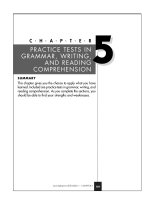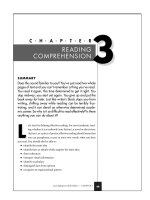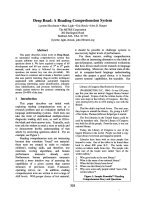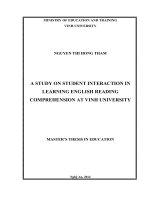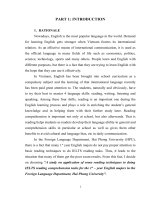9641 grand canyon a reading comprehension worksheet
Bạn đang xem bản rút gọn của tài liệu. Xem và tải ngay bản đầy đủ của tài liệu tại đây (149.12 KB, 8 trang )
The Grand Canyon
A Wonderful Place to visit
Last year, about 6.5 million people visited the United States from overseas. Most visitors
entered the country through one of the largest cities – New York, Boston, Miami, Los
Angeles, San Francisco. Then, having landed in a city, the newcomers simply “stayed put,”
not realizing that the interior of the country offered travel opportunities of unusual beauty and
interest. Did you know that between Maine and California there are 41 national parks? Some
parks cover thousands of acres. Each has its own distinctive scenery and character. If you like
nature study, hiking, camping, bird-watching, clean air, quiet, or just getting away from the
city, you will love the national parks. On the East Coast, for example, there is Acadia
NATIONAL Park, Maine. It faces the Atlantic Ocean and has a long, rocky coastline. On the
West Coast, in California, there are Yosemite, with majestic mountains, forests, and rivers;
and Death Valley, with desert plants and animals. In between are enough national and state
parks to satisfy every taste and interest: Cape Hatteras, North Carolina; Great Smoky
Mountains, Tennessee; Shenandoah, Virginia. Above all, there is the Grand Canyon, Arizona,
that mighty chasm carved in the earth by the Colorado River. Visiting a national park need not
to be expensive for the overseas visitors, but does require advance information and careful
planning.
Visiting the Grand Canyon
(1) The Grand Canyon is an impressive sight. It is 277 miles long, between 4 and 18
miles wide, and more than a mile deep. No one knows for sure how the canyon was made, but
geologist generally agree that over millions of years, the Colorado River, which runs down
the center of the canyon, gradually cut through the sand and rock to carve this mighty chasm.
This wearing-down process is called erosion. The wind and natural land movements did the
rest. Today the Grand Canyon is a geologist’s dream. The rock layers in the sides of the
canyon are exposed to view. Each layer is a record of all the natural events that happened to
the land through the eons of time. In one layer, there is dust from an ancient volcano. In
another layer, there is sand from a lake that once covered the area. In a third layer, there are
the bones of prehistoric animals. The canyon is like a storybook. If you had enough
knowledge, you could unravel the history of the earth.
(2) But studying geology is not the only interesting thing to do there. It is an ideal
place to hike, to ride a bike, to take a boat ride down the river, to camp out overnight, to take
photographs and see beautiful scenery. To add further interest, the canyon has six different
climate zones, and many kinds of plants, trees and animals.
(3) “We’ve got to see the Grand Canyon,” said José to his friend Ibrahim. José is from
Colombia, South America, and speaks Spanish. Ibrahim is from Egypt, and speaks Arabic. To
communicate, they have to speak English.
(4) “Let’s go,” said Ibrahim. “School doesn’t start for three weeks. We’ll just have
time. I saved some money from my summer job, but how will we get there? We don’t have a
car.”
(5) “There are three ways,” José said. “We could fly or go by train, but that would be
expensive, so let’s take the bus. It explains how in this booklet. There are two major
interurban bus lines in the U.S. – Greyhound and Trailways,” said José, reading from the
booklet. “These two companies operate 6700 busses and carry over 350,000,000 passengers
each year – more than the railroads and the airline combined. Best of all, bus travel is
relatively cheap.”
(6) This sounds like a great trip, and practical, too. When do we start?” asked Ibrahim.
(7) “What about Monday? That would give us plenty of time to pack.”
(8) “Monday is okay with me,” Ibrahim said. “I’m taking one suitcase, some casual
clothes, and my hiking boots.”
(9) “Travel light.” That’s my motto,” José said. “And carry traveler’s checks. They are
safer than cash.”
(10) Monday rolled around in no time. The two friends caught the bust at the depot.
Next morning, they were in Flagstaff, Arizona, gateway city to the Grand Canyon. A local bus
took them the rest of the way, about 80 miles, and dropped them at the Park entrance.
(11) Now their excitement began to rise. They could hardly wait to view the canyon
itself. But they were in for a surprise. At first there was nothing special to see. Dark green
pine trees surrounded the boys on every side. They seemed to be in the middle of a forest.
Fortunately, the trail to the canyon was well marked. “Grand Canyon this way,” read a sign.
(12) It took ten minutes of rapid walking to reach the canyon. The boys stumbled on it,
really, for there was no preparation, no gradual slope, just flat, wooded country that suddenly
disappeared into the mile-deep abyss.
(13) “Wow,” said José. “Look at that!”
(14) “Wow,” repeated Ibrahim, unable to find better words.
(15) It was a thrilling sight. The rocky precipice at the top fell straight down the
canyon floor, which was very uneven and covered with rocks. Cutting down the middle was
the wild Colorado River, although from this distance it looked like a harmless stream. The
other side of the canyon was clearly visible. Overhead, a hawk flew lazily in a cloudless sky.
The boys could see for a hundred miles in every direction.
(16) “What will we do first?” José asked
(17) Just at that moment, the boys noticed a park ranger standing beside a big picture
of the canyon. “Right now, we’re standing on the south rim, or edge, of the canyon, just about
here,” the ranger said, indicating a place on the picture. “That’s the north rim over there,” he
said, pointing across the canyon. “Did you notice how the rocks and earth are arranged like
layers in a cake, and that each layer has a different color? The layer at the bottom of the
canyon is the oldest. It is called Early Precambrian,” the ranger said, giving the scientific
name. “These rocks must be about 1.7 billion years old. The rocks on the top are younger.
each layer has a different age, and has characteristic deposits that correspond to the geological
and natural events occurring at the time. We find evidence of animal life at this level,” said
the ranger, pointing to a layer near the top. “Probably dinosaurs, extinct animals that lived
millions of years ago.”
(18) “Isn’t this interesting,” said Ibrahim. “When I get back to school, I’m going to do
some research in geology and write a paper for my science class.”
(19) Yes, it is interesting, “ said José, “but I’m getting hungry. Isn’t it time for
supper?”
(20) There were several places to eat. The boys could get fast food at a lunch stand or
dinner in the restaurant.
(21) “Let’s go to the restaurant,” said Ibrahim. “I’m starved.”
(22) After a short wait, they were seated at a table. The waiter arrived to take their
order.
(23) “I am so hungry, I could eat a dinosaur,” said José, glancing at the menu. “I’m
going to have vegetable soup, steak, mashed potatoes, lettuce salad, and ice cream for
dessert.”
(24) Ibrahim ordered mushroom soup, veal stew with rice, tomato salad, and apple pie.
(25) When the boys had finished eating, they glanced out the windows. The sun was
just setting. If they hurried, they could just get outside in time to watch the sun drop below the
canyon rim, which it did with a burst of many colors.
(26) “Wasn’t this a great day?” José said. “What’ll we do tomorrow?”
Exercises
1. Reading comprehension
On the basis of the story, decide if the following statements are true (T) or false
(F).
1. ____ The national parks in the States have similar sceneries and character.
2. ____ Death Valley is famous for its mountains, and forests.
3. ____ National parks must be expensive for the local visitors.
4. ____ Geologists suggest that the Colorado River carved this chasm.
5. ____ There are several ways to have fun in the Grand Canyon.
6. ____ Interurban busses transport less people than railroads and airlines combined.
7. ____ When you arrive at the canyon, you see nothing special but pine trees.
8. ____ The boys approached the canyon from the bottom, near the river.
9. ____ The Colorado River looked very scary in the distance.
10. ____ Some layers of the canyon have the same age.
11. ____ Neither of the boys were hungry at dinner time.
12. ____ The boys missed the sunset.
2. Scanning for information
Answer these questions according to the text.
1. What does Yosemite National Park offer for its visitors?
2. What do the layers of the canyon show?
3. What can you do in the canyon?
4. Why don’t the two boys speak with each other in Spanish?
5. Where does Ibrahim have money from for this trip?
6. How many ways are there to reach the Grand Canyon?
7. Does José like to travel with a lot of luggage?
8. How long does it take to reach the canyon from the park entrance?
9. What kind of bird did the boy see flying?
10. Who was standing beside a bid picture of the canyon?
11. What does the ranger compare the layers of the canyon to?
12. What does Ibrahim want to research?
13. What did José have for dessert?
14. What was Ibrahim’s main dish?
15. Did José find their day great?
3. Vocabulary development 1
a, Underline the following words in the text, numbered accordingly to the
paragraph where each occurs then write them into the correct places.
canyon (1)
geologist (1) erosion (1)
interurban (5) motto (9)
layer (1)
traveler’s check (9)
volcano (1)
rim (17)
lunch stand (20)
1. _____________ is a process that changes the earth’s surface through the action of natural
forces.
2. A ____________ is a deep valley or crack in the earth, often with steep sides.
3. A ______________ is a small restaurant, usually out of doors, serving mainly fast food.
4. A _______________ studies the history and structure of the earth by analyzing rocks.
5. The ______________ is the upper edge of the canyon.
6. A _______________ is a check issued by a bank or travel agency for the convenience of
travellers.
7. A _______________ is one thousand thousands.
8. A _______________ is a thickness of material, usually one of several, that forms a distinct
division.
9. A ________________ is a mountain that releases steam and molten rock from beneath the
earth’s surface.
10. ________________ refers to a bus or other system that connects two or more cities.
b, Now, use the words above to fill in the blank places.
1. The rocks in the canyon wall are arranged in horizontal ________________.
2. I only carry _______________ when I travel because it’s safer than cash.
3. The process of the wind blowing away the soil is called ________________.
4. When you are in a hurry, you might prefer eating at a ___________________.
5. The Grand ____________ is a very famous national park.
6. Why don’t we take the ____________________bus from London to Bristol?
7. My _________is: “Never give up anything.”
8. My nephew is a _______________________. He studies minerals and rocks.
9. Etna is a famous __________ in Italy.
10. Don’t go too close to the _______! It is very dangerous.
4. Vocabulary development 2
Select the words from the list below to complete the sentences. Do not use any
word more than once.
deposits
research
major
booklet
boat ride
trail
abyss
hawk
park ranger
suitcase
1. Why don’t we take a ____________________ down the river?
2. The girls walked along a _________________ to reach the Canyon.
4. A ___________________ contains useful information for visitors.
5. The Canyon is a mile-deep _____________________.
6. Geologists study rock ______________________ in the Canyon walls.
7. If you want to have more information on a subject, do some _____________ in the library.
8. A ________________flew lazily overhead.
9. The _________________ tells interesting facts to the tourists.
10. If you want to travel light, you should take only one ______________with you.
5. Synonyms
Rewrite the following sentences by replacing the word or phrase in italics with
the best synonym from the word list. Use each synonym only once.
one billion
interurban
gateway
extinct
rapidly
glanced
dinosaurs
ice cream
flat
casual
rim
chasm
major a million
cheap
barely
scientific
1. The canyon was deep and very wide. It was beautiful.
2. The boys decided to wear informal clothes for their trip.
3. There are two main between-cities bus lines in the U.S.
4. Travelling by bus is quite inexpensive.
5. The bones of ancient reptiles were found at the site.
6. You can have the best view from the edge of the canyon.
trail
burst
Arizona
7. The Spanish boy ordered frozen milk for dessert.
8. The sun set in an explosion of color.
9. One of the boys looked quickly at the menu.
10. Dinosaurs are no longer living.
11. Early Precambrian is a technical word.
12. The boys could hardly wait to see the canyon.
13. The land was level.
14. They walked very quickly in order to arrive as soon as possible.
15. These rocks are 1,000,000 years old.
6. Word-form chart
Study the following words then fill in the blank spaces with the correct form of
the words in the same order as it given in the chart. So you must use a form of
the word nature in the first sentence, geology in the second, impression in the
third, etc.)
PARTICIPLE NOUN
studied
studying
VERB
ADJECTIVE
ADVERBS
nature
natural
naturally
geology
geologist
geological
geologically
impression
impress
impressive
impressively
study
student
study
studious
studiously
knowledge
know
knowledgeable knowledgeably
history
historic
historically
expense
expensive
expensively
visibility
visible
visibly
hungry
hungrily
distant
distantly
hunger
distance
hunger
1. People like walking in the _________________ at weekends.
2. Several studies of the rocks were made ___________________.
3. Her knowledge was very ____________________.
4. My girlfriend is very ______________ but she is very pretty at the same time.
5. The park ranger was very __________________. He knew everything about the park.
6. These facts are very _________________ so you can learn a lot from them.
7. Keep a record of your _______________ so you can check how much you spend.
8. There were no clouds so the ___________________was perfect.
9. _________________ is a serious problem in the Third World.
10. We could see a beautiful hawk flying in the _________________________.
Well done!

